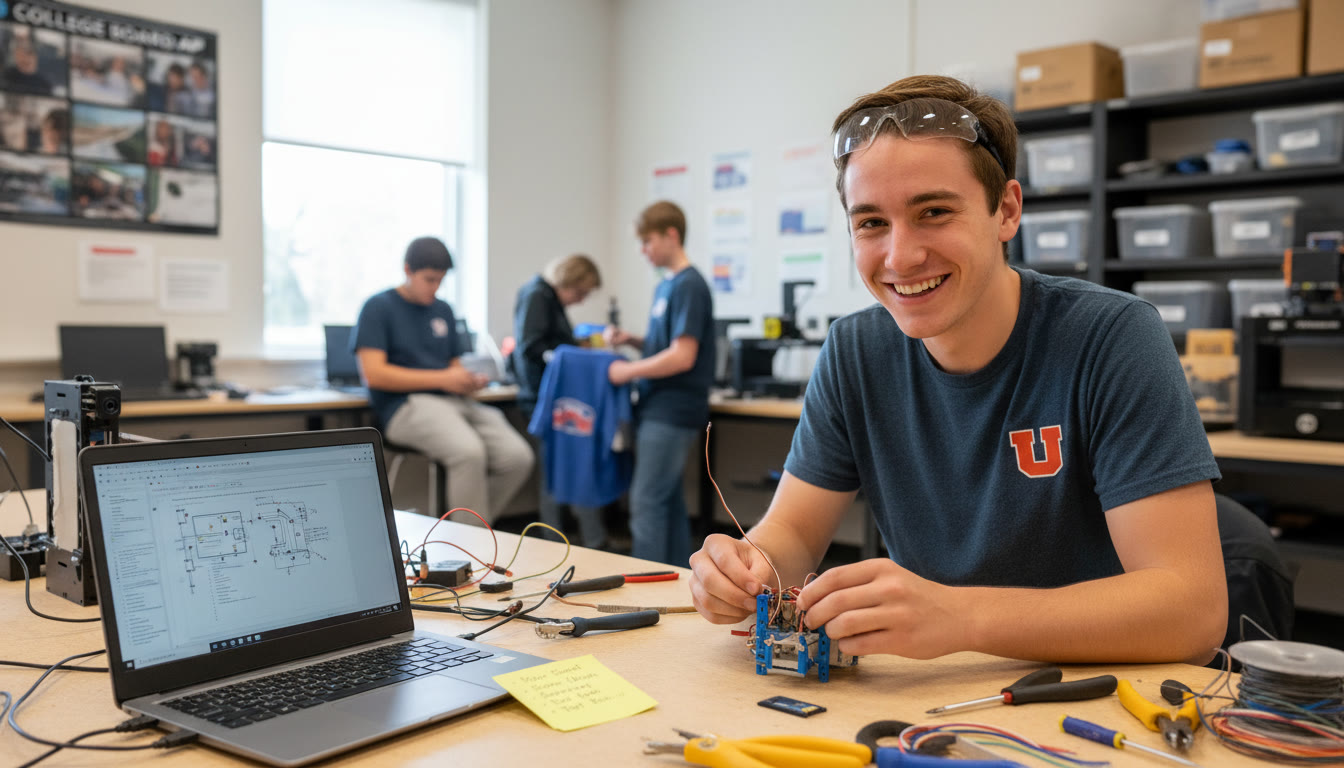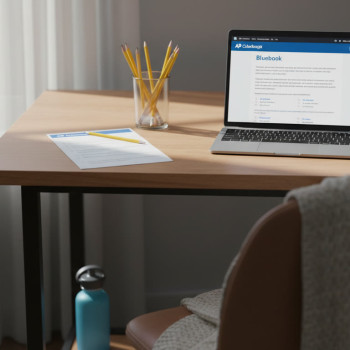Why Utah Students Should Pair AP Courses with Engineering or Business Tracks
If you live in Utah and you’re thinking about college — whether you’re an aspiring engineer who loves building things or a future business leader who loves solving problems — Advanced Placement (AP) courses are one of the best tools in your toolkit. They show colleges that you’re willing to tackle challenging material, let you potentially earn college credit, and build a strong academic foundation for specialized majors like engineering and business.
This guide is written for students and parents who want a clear, human, and practical roadmap: which AP courses to consider, how to structure a high school plan, what admissions officers look for, and how to get the kind of targeted help that actually moves the needle. Along the way you’ll see real-world context, sample course plans, and tips on study strategies and time management. And because one size doesn’t fit all, I’ll note where personalized tutoring — such as Sparkl’s 1-on-1 guidance and tailored study plans — can fit naturally into your journey.
Understanding the Two Tracks: Engineering vs Business
At first glance, engineering and business might seem like very different paths. In reality, they share many core skills: problem solving, clear communication, and the ability to apply quantitative reasoning. AP courses can be chosen and combined to strengthen either path while keeping future options open.
What Engineering Track Looks Like
- Heavy emphasis on math and science.
- AP courses that build technical foundations and signal readiness: AP Calculus AB/BC, AP Physics 1/2 or AP Physics C, AP Chemistry, and sometimes AP Computer Science A.
- Project-based experiences: robotics clubs, science fairs, Makerspace projects, and internships with local tech firms or university labs.
What Business Track Looks Like
- Blend of quantitative skills and communication/analysis.
- AP courses that matter: AP Microeconomics, AP Macroeconomics, AP Statistics, AP Calculus (especially for finance or analytics), and AP English or AP Seminar for strong writing and presentation skills.
- Real-world exposure: DECA, Junior Achievement, internships with small businesses, or running a student-led enterprise.
AP Course Recommendations for Utah Students
Below are course combinations tailored for each track. Think of these as flexible templates rather than rigid rules. Your school’s AP offerings may vary, and that’s okay — there are multiple ways to get the same underlying preparation.
Engineering-Focused AP Plan (Typical Four-Year High School Sequence)
- Freshman Year: Honors Algebra II / Geometry, AP Computer Science Principles (if available), introductory robotics or math club.
- Sophomore Year: AP Physics 1 and/or AP Chemistry, Pre-Calculus or beginning AP Calculus AB prep.
- Junior Year: AP Calculus AB or BC, AP Physics C (mechanics) if offered, AP Computer Science A.
- Senior Year: Advanced AP Calculus topics (if needed), AP Physics C (electricity and magnetism) or additional STEM electives, capstone project.
Business-Focused AP Plan (Typical Four-Year High School Sequence)
- Freshman Year: Algebra II / Geometry, introductory economics club, strong English foundation (AP English Language prep).
- Sophomore Year: AP Microeconomics or AP Macroeconomics (if offered), AP Statistics, continued involvement in business-related activities.
- Junior Year: AP Calculus AB (for quantitative majors), AP English Language or AP Seminar, internships or DECA competitions.
- Senior Year: AP Macroeconomics or Microeconomics (whichever you didn’t do), AP Statistics (if not taken), AP Research or senior capstone project.
Mixed/Exploratory Plan — If You Want to Keep Both Doors Open
- Take AP Calculus AB early, pair it with AP Physics 1 and AP Statistics, and add AP Microeconomics or AP Computer Science A depending on interest.
- This approach shows both numerical grit and intellectual breadth — a strong signal for engineering schools that value problem solving and for business programs that want quantitative acumen.
How AP Choices Affect College Admissions in Utah and Beyond
Admissions officers look for both rigor and fit. Rigor means challenging yourself relative to what your high school offers: a student in a smaller Utah high school who takes every available AP course demonstrates rigor just as well as a student in a larger school taking a full AP slate. Fit means your course choices should align with your intended major or signal genuine intellectual curiosity.
Examples of how this plays out:
- A student applying to an engineering program who takes AP Calculus BC, AP Physics C, and AP Computer Science A shows direct preparation.
- A student aiming for a business program who pairs AP Statistics, AP Microeconomics, and strong writing APs (AP English Language / AP Seminar) demonstrates analytical and communication strengths.
Practical Tips: Scheduling, Workload, and Strategic AP Exam Choices
AP exams are a marathon, not a sprint. Successful students plan not only which APs to take, but when to take them.
Timing and Load
- Limit AP exam-heavy semesters: one to three APs per semester is a realistic goal for many students, though highly motivated students sometimes handle more.
- Stack complementary subjects: taking AP Calculus and AP Physics in the same year often works well because the subjects reinforce each other.
- Use junior year strategically — it’s commonly the semester when admissions officers pay the most attention to coursework.
Choosing Which AP Exams to Prioritize
- Prioritize depth for your intended major: engineering applicants should prioritize calculus and physics; business applicants should prioritize statistics and economics.
- Balance with GPA: if a challenging AP would dramatically lower your GPA because it’s not a strength, consider alternatives like dual enrollment or targeted tutoring to boost performance.
Study Strategies That Work — Beyond Doing the Homework
Studying for APs is as much about strategy as it is about content. Effective strategies save time and improve recall.
Active Learning Over Passive Reading
- Practice problems first. For math and physics, do problems before re-reading theory.
- Teach the concept. Explaining a concept to a peer or parent reveals gaps quickly.
Build a Test-Ready Toolbox
- Flashcards for formulas and definitions (digital or paper).
- Timed practice exams to simulate real test conditions and reduce anxiety.
- Problem logs — track mistakes and categorize them (concept error, careless mistake, algebra error) so you know how to improve.
Sample Study Calendar (6–8 Weeks for One AP Exam)
| Week | Focus | Activities |
|---|---|---|
| Weeks 1–2 | Content Review | Outline key units, complete daily mini-quizzes, create formula/term flashcards. |
| Weeks 3–4 | Application | Do full-length sections, timed problem sets, and begin practice FRQs (free response questions). |
| Week 5 | Full Mock Exam | Take a former AP exam under timed conditions; grade it; analyze mistakes in your problem log. |
| Week 6 | Polish | Targeted review on weak areas, quick refresh of formulas, rest, and exam-day logistics. |
Extracurriculars and Real-World Context That Strengthen an Application
Colleges want to see initiative and sustained interests. For both engineering and business tracks, meaningful projects and leadership roles matter more than a long list of disconnected activities.
Engineering Examples
- Build a project (robot, app, solar car) and document it. A short portfolio or GitHub repo can be powerful.
- Join or lead robotics clubs, participate in state competitions, or seek summer STEM programs at nearby universities.
Business Examples
- Start a small venture or run a school store: track revenue, refine a business plan, and describe results — numbers make a story credible.
- Compete in DECA or manage a club finance portfolio, showing leadership and measurable impact.
How Personalized Tutoring and Targeted Support Can Help
Many students benefit from outside guidance — not because they’re struggling, but because targeted help makes progress faster and more efficient. Personalized tutoring can help with tricky AP concepts, time management, and college application strategy.
For example, Sparkl’s personalized tutoring offers 1-on-1 guidance, tailored study plans, expert tutors, and AI-driven insights. That combination can be particularly useful when you need to convert weak areas into reliable performance — say, improving AP Physics problem-solving or getting AP Calculus to a confident level before a mock exam. The right tutor helps you prioritize what matters most, reduces wasted study time, and builds confidence through achievable milestones.
Local Considerations for Utah Students
Utah has a thriving education scene with strong public and private schools, vibrant STEM outreach, and universities that actively recruit in-state talent. Take advantage of local resources: community college dual-enrollment options, Utah universities’ summer programs, and statewide competitions. These experiences can complement AP coursework and give you practical examples to write about in essays and interviews.
Putting It Together: Sample Four-Year Roadmap
The roadmap below is a sample that balances AP rigor with extracurricular depth. It’s adaptable depending on school offerings and personal pace.
| Year | Engineering Track (Example) | Business Track (Example) |
|---|---|---|
| 9th Grade | Honors Algebra II, Intro to Engineering/Robotics, AP Computer Science Principles (if available) | Algebra II, Intro to Business Club/DECA, AP Human Geography (if offered) |
| 10th Grade | Pre-Calculus, AP Physics 1, Science Fair Project | AP Statistics, AP Microeconomics, Business Internship or DECA competitions |
| 11th Grade | AP Calculus AB/BC, AP Physics C (Mechanics), AP Chemistry (optional) | AP Calculus AB, AP English Language, AP Micro or Macro depending on availability |
| 12th Grade | Advanced STEM electives, senior capstone or research, additional APs as fit | AP Macroeconomics, AP Research or AP Seminar, business capstone |
Application Tips: Essays, Letters, and Interviews
AP scores alone won’t get you into top programs — your application narrative matters. Use essays to connect AP coursework with experiences: how a complicated physics lab taught you to iterate, or how an economics project shaped your view of markets.
- Letters of recommendation should come from teachers who can speak to growth and problem solving (AP teachers are ideal if they know you well).
- Use interview opportunities to talk about projects and AP challenges — concrete examples (a problem you solved or a lab that failed and how you responded) are more memorable than abstract praise.
Common Pitfalls and How to Avoid Them
- Overloading on APs without depth. Taking many AP classes but not performing well looks worse than taking a focused set and excelling.
- Ignoring soft skills. Engineers and business students both need to communicate clearly — don’t skip AP English or a speech/debate class if communication is weak.
- Leaving everything to the last minute. College-prep is cumulative; start early and use periodic check-ins (quarterly) to adjust your plan.
Real-World Example: From High School Project to College Research
Imagine a student named Maya in Salt Lake City who loved renewable energy. In 10th grade she took AP Physics 1 and AP Chemistry, joined a local makerspace, and built a small solar charger. With guidance from a mentor and targeted tutoring in advanced physics topics, she refined her project into a summer research experience. Her AP scores proved mastery of fundamentals, while her capstone and research showed initiative — a powerful combination on college applications.
That narrative works whether you’re leaning engineering or business: the technical APs show capability; the project shows application; and a thoughtful essay explains motivation.
Final Checklist for Utah Students and Parents
- Choose APs that align with your intended major — depth matters.
- Balance AP workload with quality extracurriculars and rest.
- Use timed practice exams and problem logs to track improvement.
- Consider personalized tutoring (1-on-1 guidance and tailored study plans) to close gaps quickly — Sparkl-style support can be particularly effective for tricky quantitative APs.
- Develop at least one project or leadership experience that shows sustained interest.
- Plan junior year carefully; that’s a showcase year for admissions.


Parting Thoughts: Keep Perspective and Enjoy the Learning
AP courses are a means to an end, not the end itself. They open doors, build confidence, and prepare you for the kind of thinking colleges and employers prize. Whether you’re in the Wasatch Front or a smaller Utah community, a thoughtful mix of AP coursework, real projects, and guided support will keep your options wide and your skills sharp.
Get curious, experiment with projects, and if you need focused help, consider targeted, personalized tutoring to accelerate progress. With smart planning and steady effort, Utah students have every reason to aim high.
Ready to Start?
Talk through your high school plan with a counselor, map out which APs fit your goals, and identify one meaningful project to pursue this year. If a tutor would help — whether for AP Calculus, AP Physics, AP Statistics, or AP Economics — seek a program that offers tailored study plans and regular progress checks to keep you on track.
Good luck — and remember: thoughtful choices, steady practice, and meaningful experiences matter more than the number of APs on your transcript. Aim for clarity over volume, and your application will tell a compelling story.

















No Comments
Leave a comment Cancel